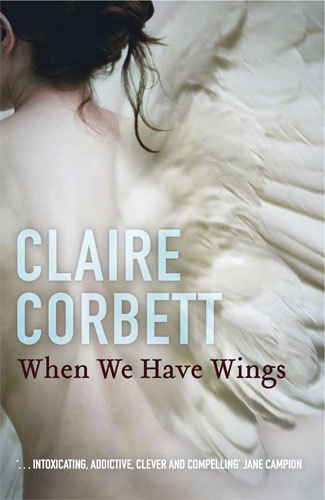 When We Have Wings by Claire Corbett is set in a vaguely near future Sydney where the rich can fly thanks to having wings implanted on their backs.
When We Have Wings by Claire Corbett is set in a vaguely near future Sydney where the rich can fly thanks to having wings implanted on their backs.
Before I get into talking about the story, I want to point out that, from a physics point of view, Corbett has described a very plausible situation. The wings people get are quite large (the impression I got was comparable to the height of the person) and they also get treatments to change the physiology to make their bones lighter (carbon fibre was involved) and their muscles stronger. And, of course, to grow the new muscles needed to control their wings. (For the record, the fictional wings were larger and more interestingly-coloured than on the cover, although it’s a nice cover despite that.)
I have little idea of how plausible the biology was, but assuming those biological modifications were possible, the physics seemed to check out (y’know, without actually writing out equations or anything). The descriptions of flight and weather patterns were also quite rigorous and I commend Corbett on her dedicated research. Those details made the book all the more realistic and helped with the suspension of disbelief so we could focus on the social issues surrounding flight.
The story follows two characters: Zeke, a PI investigating a nanny kidnapping the child of a flyer couple, and Peri, the nanny on the run. The mystery of why and where the nanny took the baby is not the real mystery, however — especially since about half the story is told from her point of view. The real mysteries become apparent when Zeke digs a little deeper and when events get away from everyone.
The setting isn’t a dystopia. Similar to what I said about Spare Parts, just because there is a widening gap between haves and have nots, doesn’t make it a dystopia. Especially when, other than the size of the gap, there aren’t many social or political differences to our world. It’s a commentary on where our world could go, given enough scientific progress. And it doesn’t make the assumption that the medical developments are inherently a bad thing, either. Partly, this is explored through Zeke having to make a choice as to whether to give his toddler son wings from an early age (it’s easier when they’re children) or whether to deprive him of flight and bar entrance into the elite flyer society.
In many ways, flight is a metaphor in When We Have Wings. However, it’s not just a metaphor, as evidenced by the rigorous world building and the real exploration of social issues surrounding flight. What makes us human? How much of a disadvantage is not being able to afford wings? Is being an ordinary human (in their world), without modification, edging towards being a disability since they can’t fly? There was a lot of background political discussion about equality and quotas (of non-modified humans) and equal access. In a world where everyone is expected to choose the most favourable characteristics for their unborn children and concerns like baldness are trivial to “fix” where do you draw the line? If you want an unadulterated genome, where does that leave you (other than as a member of the conservative anti-modification cult)?
Progress marches on.
When We Have Wings was an excellent read. I highly recommend it to fans of science fiction, fantasy and anything in between. I suspect it’s being at least partially marketed as main stream, so hey, all readers of fiction, go out and buy it!
4.5 / 5 stars

No comments:
Post a Comment
Note: only a member of this blog may post a comment.